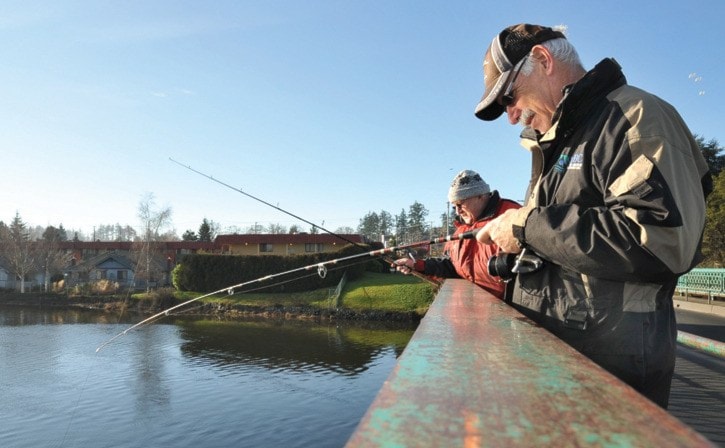Bob Briggs remembers pulling 60 fish out of the Gorge Waterway on a good day.
Meandering over to the Craigflower bridge, sometimes with friends, he recalls taking more than 500 fish out of the Gorge over the two month spawning period. He still fishes there today, but his catch is down to about 50 – and he wonders where all the herring have gone.
“It was nothing to go down and get a bucketful of fishing herring six years ago,” he said. “There is no way you could fill a bucket in an hour or two now. (But) why?”
Briggs says the days of pulling up with a single bamboo pole and jigs and yanking herring out of the water one after the other are over, as are the days of dozens of longtime anglers lining the Craigflower bridge with lines in the water and overflowing buckets at their feet.
The decline is clear, but the reason is not. If anything, water in the Gorge is the cleanest it’s been since the 1920s. Health Canada has given the water a clean bill of health, and it’s even become a swimming hole again.
With construction of a new Craigflower bridge set to begin in April, World Fisheries Trust executive director Joachim (Yogi) Carolsfeld hopes to bring new awareness to the issue.
“It is a unique thing in the Gorge. There are not many places where you can get this in the middle of the city,” Carolsfeld said. “It is on its way out and we have to do something.”
He’s heard plenty of anecdotal evidence regarding the food and bait fish, but he says he needs concrete facts and hopes to fund a creel survey, a monitoring method relying on surveying and interviewing fishermen on a daily basis.
In order to do that, funds are needed for a co-ordinator to design and set up the survey – with volunteers required to observe spawning that isn’t currently happening.
“In the Gorge itself, I never heard of any herring actually coming back last year,” said Andrew Paine, founder of the Salish Sea Herring Enhancement Society.
“We did lots of visits around the Gorge during spawning season. It is pretty disheartening we didn’t see any spawning activity in the Gorge.”
Paine said multiple factors could be contributing to the decline including commercial overfishing, especially when pregnant females are targeted for their prized roe, a practice he sees as effectively eliminating future generations before they are even born.
Another issue Paine points to is an abundance of creosote-treated wood pilings which he says kill herring eggs.
“We witnessed billions of eggs dying on the creosote pilings last year,” he said. “We went when the spawning was happening which is a really incredible experience. In the kelp and eel grass they hatched and that was it. On the creosote pilings they died.”
Creosote, a preservative added to wood in some commercial marine applications including docks and marine structures, leeches chemicals into the water which harms fish roe, he said.
“It’s the toxic shock, the chemicals that leech out. They have done studies on it so there is evidence there,” Paine said.
It doesn’t kill all marine life though – a federal environmental assessment of Craigflower bridge last year found higher densities of oysters at the piling than other areas of the Gorge.
Paine and a group of volunteers are targeting a technique focused on enhancing the fish habitat by covering the wood with a landscaping cloth, shielding roe from direct contact.
They will test the technique on herring stock in the Saanich Inlet first. Paine says a similar technique, coupled with information gathered from proper monitoring, may help the Gorge bounce back.
“The herring are the building blocks pretty much of our whole ecosystem. The herring feed the salmon, they feed the ling cod they feed the seals, that feeds the orcas and everything,” Paine said.
“(They) really are a keystone species in our ecosystem. It is really sad we are losing populations like the Gorge herring. Once they are gone, are they ever going to come back?”
For more information visit worldfish.org.
alim@vicnews.com
